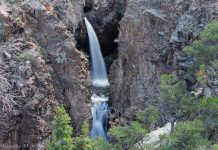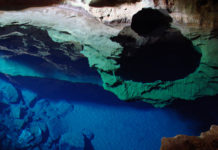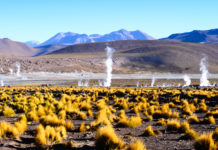The imposing Fortress of Kuélap is the main attraction of the Chachapoyas region. It ranks among the finest and most inspiring remains in Peru. The structure occupies a great vantage point, set on a thespian ridge high above the Río Utcubamba amid verdant, rolling countryside.
Therefore, reclaimed by the surrounding forest for more than 310 years, it wasn’t until 1843 that the area was rediscovered by a local judge, and it wasn’t in fact explored until the late 19th and early 20th centuries. However, the local specialists claim the fortress contained three times more stones than the Great Pyramid at Giza in Egypt.
The massive perimeter wall, made of enormous limestone blocks, was maybe built for defense purposes. In some places, the wall reaches a height of 36 feet (11 meters) and encircles the entire site. On the southern side of the citadel, a strange inverted cone-shaped structure, El Tintero (inkwell) rises 18 feet (5.5 meters) high.
Main Entrance – The funnel-shaped defensive entrance is still used today. There are only three entrances to the fortress. Located on a limestone ridge that runs north-south, the fortress was built to maximize the natural topography of the area against enemy raids. A recovery project to restore some of the ruins has been going on at the site since 1999.
The great tower at the northern end is one of the main features of the wreck. It’s a D-shaped lookout tower. Hundreds of round stone houses are scattered arbitrarily throughout the place. They were once about 13-feet (4-meters) high and had thatched roofs Ceramics exposed in Kuélap indicate that the area had been inhabited since AD 500, but the greater part of construction occurred between AD 900 and 1100.
The end result is a fortress larger than any other single structure in Peru. The complex had an outer wall protecting more than four hundred circular houses, thought to have been home to 3,500 people. It also had terraces, outlying settlements, and burial places outside the main walls.
When the Incas arrived around 1470, they found that Kuélap, full of ferocious Chachapoyan warriors, was no easy place to conquer. They were unable to conquer the Fortress of Kuélap properly and only five Inca buildings have been found among the hundreds of structures in the fortress.
Nonetheless, only three main entrances to the fort, all very comparable to each other, however; only one is in use nowadays. The funnel-shaped entrance leads into the fortress and becomes narrower the farther in one goes until eventually, it is wide enough for only one person.
The rock-hard walls rise high above the head. Thus, the construction of the entrance is an obvious pointer to the truth that no one could have gained entry into the Fortress of Kuélap without the inhabitants allowing them admission.
El Tintero – It is the most popular structure within the walls. Although the word means “inkwell” due to the structure’s unusual shape, an inverted cone, not because of any reference to ink since the Chachapoyans did not have a written language. Thus, the premature surveys gave a variety of functions to this building, ranging from a water reservoir to jail – even a torture chamber and a cemetery.
However, the current studies suggest that the building had astronomical functions, since the undersized entrance lines up with the sun at the most constructive times for planting crops. In reality, the reason for this strangely shaped structure still remains secret. A minute human face carved in low relief into a limestone block can be observed on the eastern side of El Tintero.
Circular Buildings – A distinct from all other buildings in Peru, the Chachapoyans left circular structures for posterity to be in awe of and ponder over. Thus, no one knows why they were beautifully circular. A few have been restored in Kuélap and somewhere else. Most investigators agree that the buildings had sheer, conical thatched roofs designed to ward off torrential cloud-forest downpours.
In Kuélap, some of the buildings have walls 20 inches (50 cm) thick. The apparently random order of these buildings is quite deceptive. Archaeologists claim the design is quite rational, with the buildings being distributed either along corridors or arranged with the patios facing each other.
Torreón – This 23 feet (7-meters) high tower at the north end of Pueblo Alto gave 360 views in every direction. Archaeologists found an arsenal of broken stone axe heads and over 2,500 stones piled on the floor, of a faultless size to fit in the slingshots that defenders would have used.
Water Channels – Stone channels have been found leading archaeologists to believe they may have led to a spring at the top of the ridge, which must have provided the fortress with a permanent source of water. The name Chachapoya is usually supposed to come from the conflation of two Quechua words, sacha and puyu, literally forest-cloud.
The Chachapoyans people were famous for their white skin and beauty. They were a ferocious community and it took the Incas a lot of men to conquer the region. They were also well-known shamans, recognized as great sorcerers and herbalists. The people were skilled in the agricultural areas, and also prominent for their weaving.
The finds displayed at the Museo Leymebamba testify to the beauty of the imagery and the wide variety of techniques used, including plain weaves, tapestry, brocades, and embroidery on a single textile. They also formed a wide range of pottery. Hence, the Fortress of Kuélap is must visit the place.







Related Reading – The Mysterious Boiling River of Mayantuyacu, Peru







